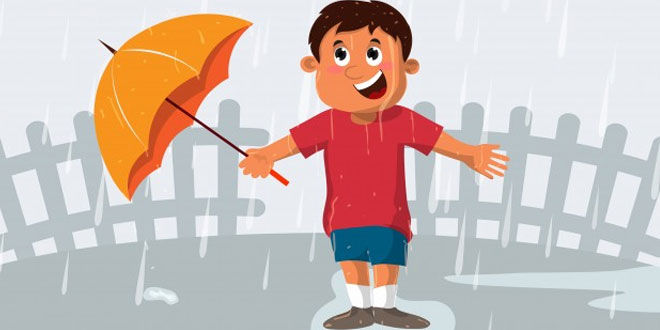Question: What is cyclonic rainfall?
Answer: This type of rainfall takes place when a cold air mass and a warm air mass strike each other face to face. As cold air is denser, it remains close to the ground, while the warm air rises above it. As it rises, it expands and cools resulting in rainfall. Rainfall of this type is mostly seen in the tropical and temperate regions where cold polar winds meet the warm westerly winds.
Question: Explain the occurrence of hail.
Answer: When falling raindrops are thrown back high above the clouds by rising air currents, they freeze and become ice pellets. If the tossing process takes place many times then more layers of ice form around the pellets giving them an onion like pattern. When these pellets become heavy they fall down as hailstones.
Question: What do you understand by windward and leeward sides?
Answer: The side of a mountain that faces the rain bearing winds from the sea is called the windward side. It receives heavy rain. Winds after crossing the mountain are left with little moisture for the other side of the mountain which remains relatively dry. This dry side is called the leeward or the rain shadow side of the mountain.
Question: Write a short note on clouds.
Answer: Clouds are floating masses of super-cooled water droplets and ice crystals. Each of these droplets of water is smaller than a grain of flour, and they are so light that they can float on air. There are three main types of clouds. They are cirrus clouds, stratus clouds and cumulus clouds.
Cirrus Clouds: They are thin, wispy clouds that streak across the sky. They are found high up in the atmosphere and are made up of ice crystals.
Stratus Clouds: They are low lying clouds and appear as large, grey sheets covering the entire sky.
Cumulus Clouds: They are massive, billowing clouds that often extend to great altitudes.
Question: Explain in brief the types of rainfall.
Answer: There are three types of rainfall-convectional rainfall, orographic rainfall and cyclonic rainfall.
Convectional Rainfall: Convectional rainfall is common in places with equatorial and tropical climates, where intense heating of the Earth’s surface takes place during the day.
- During the course of the day, the air above the land becomes heated making the air less dense, so it rises up.
- As the air rises it cools. Since cool air cannot hold as much water vapour as warm air, condensation occurs.
- Towering thunderstorm clouds (cumulonimbus clouds) are formed.
- When the weight of the water in these clouds becomes more than the cloud can hold, the water comes down as a huge downpour.
Orographic Rainfall: Relief rainfall or orographic rainfall is caused by the relief or orography of the land.
- When moisture laden winds encounter mountains or hills, the air is forced to rise up the slope of the mountains. when sir rises, it cools, condenses and form clouds.
- When the dew point of the air is reached, it can no longer hold all its water, which comes down to the earth’s surface as heavy rain.
For example: The monsoon rains that occur along the Western Ghats and the Himalayan foothills. When the moisture laden monsoon winds hit the western Ghat and the Himalayas, the air mass is forced to rise. Monsoon winds bring copious rainfall to the windward side of these mountain ranges. The area which lie on the leeward side of the Western Ghats, like Coimbatore, get less rain. This is called the rain shadow region.
Cyclonic or Frontal Rainfall: This type of rainfall is common in the Tropical and Temperate zones, where the mixing of cold air with warm and moist air occurs. It is associated with cyclones in the tropical regions and depressions in the temperate zone.
- When an area of low pressure (or a depression) is created, winds rush into the pocket of low pressure from all sides. At times, there is a mixing of cold air masses with warm air masses within low pressure system.
- The point where the warm mass of air meets the cold air mass is called front. When they meet, warm air being lighter is forced to rise above the denser, heavier cold air.
- As the warm air is forced upwards it cools. When the temperature drops to below the dew point, when the air can no longer hold all its water, the water starts to condense and form clouds that cause rain. Such rain is called frontal or cyclonic rainfall.
 Class Notes NCERT Solutions for CBSE Students
Class Notes NCERT Solutions for CBSE Students


